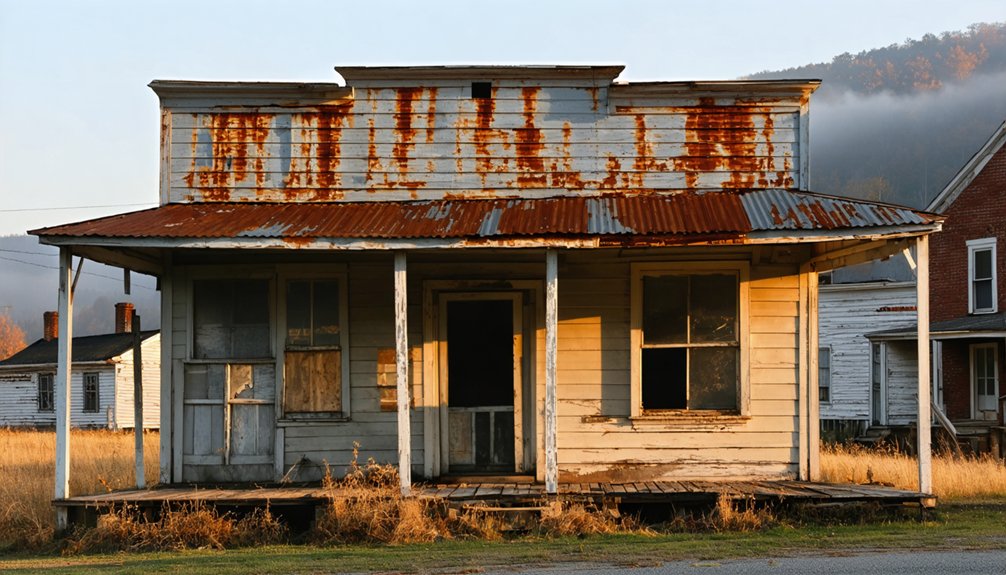You’ll find only remnants of Tin Can Alley, a Kentucky coal mining settlement that emerged in the 1820s as part of Muhlenberg County’s industrial expansion. The community thrived with company-owned wooden homes, strict work schedules, and tight-knit family networks until its mysterious abandonment on October 16, 1962. Today, crumbling foundations and haunting tales of phantom miners mark this ghost town’s location, while preservation efforts work to document its rich historical legacy. The full story reveals an even darker chapter in Kentucky’s mining history.
Key Takeaways
- Tin Can Alley was a Kentucky coal mining community established in the 1800s, featuring wooden frame houses and company-controlled infrastructure.
- Residents experienced tough living conditions with overcrowded housing, shared outhouses, and complete economic dependence on mining operations.
- The entire population mysteriously vanished on October 16, 1962, following the decline of coal mining operations in the area.
- Ghost sightings include reports of soot-covered figures near the treeline and phantom sounds attributed to spirits of former miners.
- Preservation efforts by Kentucky Heritage Council aim to document and protect the abandoned town’s remaining structures and historical significance.
The Rise of a Kentucky Coal Mining Settlement
When Thomas Walker first discovered coal in Kentucky in 1750, he couldn’t have imagined how this natural resource would transform the state’s landscape and economy.
By 1820, the first commercial mines emerged in Muhlenberg County, sparking a wave of development that would reshape the region’s community dynamics. Native Americans had utilized these coal resources long before recorded history. Production grew dramatically, reaching one million tons by 1879. You’d have found company towns sprouting up around the mines, complete with railroad connections, company stores, and worker housing.
The cultural heritage of these settlements took shape as mining companies built essential infrastructure, including schools, medical facilities, and commissaries.
As production soared through the late 1920s, you’d have witnessed the evolution of tight-knit communities, where life revolved around the mines.
The Eastern Coalfield’s development in 1879 further accelerated this transformation, creating new opportunities and challenges for Kentucky’s growing mining settlements.
Daily Life in Tin Can Alley
If you’d visited Tin Can Alley during its peak, you’d have found miners’ families living in tightly packed wooden houses, often sharing outhouses and managing without indoor plumbing.
The men’s daily schedule revolved around grueling mine shifts, while women maintained households and supplemented family income through domestic work or small-scale farming. Like the pioneers at Floyd’s Station, the community built fortified structures to protect themselves from outside threats. To avoid confusion with other locations named Tin Can Alley, residents often referred to their town as the Kentucky Settlement.
Despite harsh conditions, residents fostered strong community bonds through church gatherings, local events, and informal support networks that helped them cope with the uncertainties of mining life.
Mining Family Housing Life
Life in Tin Can Alley revolved around company-owned wooden frame houses where mining families endured challenging conditions that shaped their daily existence.
You’d have found these basic structures arranged in tight rows near mine entrances, lacking modern amenities like indoor plumbing or central heating. Housing challenges included overcrowded rooms where multiple family members shared limited space, relying on coal stoves for warmth. With an average of 2.4 people per household, cramped quarters were a constant reality.
Family dynamics centered on strict roles: men worked grueling mine shifts, women managed households under difficult conditions, and children helped with essential tasks like fetching water or tending gardens. Child labor laws were frequently ignored as children as young as nine worked in the mines.
You’d have seen extended families living nearby, creating crucial support networks. Despite the hardships of company control and economic dependency, families found ways to survive through community sharing, subsistence gardening, and preserving food for lean times.
Work and Community Schedule
Beyond the confines of family homes, Tin Can Alley operated on a strict schedule dictated by the mining industry‘s demands. You’d find miners rising before dawn, heading to the mines for grueling 10-12 hour shifts, while their families adapted to the rhythms of coal town life. The heavy silence that now pervades these abandoned streets stands in stark contrast to the once-bustling daily routines.
Work schedules dominated six days a week, with Sundays reserved for rest and worship. Unlike the town of Edmonson where fresh milk remained in refrigerators after its residents vanished, Tin Can Alley’s abandonment was a gradual process.
Community roles extended beyond the mines. You might’ve bartered at the general store, where miners often relied on credit between paydays.
Women managed households while children split time between school and home duties. During precious free moments, you’d gather with neighbors for informal social events – perhaps a baseball game or community picnic.
As mining operations eventually declined, these carefully structured routines unraveled, leading to the town’s gradual abandonment.
Economic Backbone and Mining Operations
As you’d explore the economic history of Tin Can Alley, you’d discover a rigid company employment structure where workers lived in company housing and relied on company stores, effectively binding them to the mining operation through economic dependency.
The town’s coal production reached its zenith during the post-World War II mechanization boom, when modern equipment replaced traditional pick-and-shovel methods. Social reformers at the time advocated for planned industrial towns to improve the harsh living conditions of mining families. Following the model of early developers like Wisconsin Steel Company, the mining operations acquired vast land holdings to establish their industrial footprint.
Mining companies exercised near-total control over workers’ lives through a scrip payment system, which could only be redeemed at company-owned establishments, ensuring wages remained within the corporate ecosystem.
Mining Company Employment Structure
Mining companies in Eastern Kentucky established intricate employment hierarchies that formed the economic foundation of coal towns like Tin Can Alley.
You’d find various job roles throughout the operations, from skilled miners and engineers to unskilled laborers loading coal at the tipple. The companies structured their workforce with boards of directors at the top, followed by general managers who oversaw mining divisions, while superintendents controlled individual mines.
Labor conditions were challenging, with workers facing constant safety risks from methane gas and explosions. You’d likely have lived in company housing and been paid partially in scrip – company currency that kept you tied to their stores.
While foremen supervised the underground crews, support staff like mechanics and clerks kept the operation running smoothly above ground.
Coal Production Peak Years
While Kentucky’s coal industry had modest beginnings in the 1750s, it reached unprecedented heights during the peak production years of 1910-1930.
You’ll find that eastern Kentucky’s output dominated the coal market, with Harlan and Pike counties leading production. The region experienced dramatic coal market fluctuations, particularly during World Wars I and II, when military demands drove production to new highs.
In places like Tin Can Alley, you’d have witnessed the transformation from rural farmland to bustling coal towns.
Mining labor strikes emerged as workers fought against the company store system and scrip wages. By the late 1920s, mechanization had revolutionized mining operations, though this prosperity wouldn’t last forever.
The boom times created an economic backbone that shaped the region’s identity, even as it left lasting social and environmental challenges.
The Decline and Abandonment Era
During the mid-twentieth century, Tin Can Alley’s economic foundation crumbled beneath the weight of coal industry decline, setting off a devastating chain of events that would transform this once-vibrant Kentucky mining community into a ghost town.
You’d have witnessed a stark economic impact as mining operations ceased, forcing families to abandon their homes in search of work elsewhere.
Population trends showed a familiar pattern: young residents left first, followed by working-age adults, leaving behind an aging community that eventually dissolved entirely.
Like leaves from a dying tree, residents peeled away – first the young, then their parents, until only memories remained.
As tax revenues dried up, infrastructure fell into disrepair. Roads deteriorated, utilities failed, and empty buildings succumbed to nature’s reclamation.
Without formal incorporation status, Tin Can Alley’s administrative identity faded quickly. The town vanished from maps and official records, becoming just another lost chapter in Appalachia’s coal country history.
Haunting Tales and Local Legends

The haunting tales of Tin Can Alley emerged in parallel with its physical deterioration, as abandoned buildings and silent streets bred stories of supernatural encounters.
You’ll find the most chilling accounts centered around October 16, 1962, when Edmonson’s population mysteriously vanished, leaving behind only empty homes and unanswered questions.
In the coal-dusted ruins, you might hear phantom sounds that locals attribute to restless miners’ spirits.
They’ll tell you about ghostly apparitions of soot-covered figures standing guard at the treeline, and supernatural folklore involving miners reliving their final moments near abandoned bathhouses.
Biblical interpretations have woven apocalyptic themes into these stories, with some residents citing Revelation 9:1 to explain the haunting emptiness that pervades the region’s ghost towns.
Preserving the Memory of Lost Communities
As abandoned communities across Kentucky face natural reclamation and decay, preservation efforts have emerged through a robust framework of legal protections and community initiatives.
You’ll find organizations like the Kentucky Heritage Council and Preservation Kentucky working to document and protect these vanishing places through preservation easements and detailed site analysis.
When you explore lost communities like Tin Can Alley, you’re witnessing preservation challenges firsthand – from overgrown vegetation to structural instability.
Yet these sites remain essential to community heritage, connecting you to Kentucky’s past through careful documentation and public education programs.
Abandoned Kentucky places serve as vital windows into our shared past, preserved through meticulous records and community learning initiatives.
The state’s preservation framework offers tools to protect these historical treasures, including tax incentives for property owners and guidelines for sensitive restoration, ensuring future generations can experience these tangible links to Kentucky’s history.
Frequently Asked Questions
What Happened to the Original Property Deeds of Tin Can Alley Residents?
You’ll find that property ownership stayed with coal companies who kept the deeds. When mines closed, they either took or abandoned these documents, leaving deed history uncertain and most records lost or destroyed.
Were There Any Documented Major Mining Accidents at Tin Can Alley?
You won’t find any documented major mining accidents at this site – historical mining safety records and accident reports from Kentucky’s databases don’t indicate any significant disasters occurred there specifically.
Why Was the Unusual Name “Tin Can Alley” Chosen for This Settlement?
You won’t find documented proof of the name’s origin, but historians speculate it came from residents’ use of tin cans in makeshift housing construction – reflecting the settlement’s resourceful pioneering spirit.
How Many People Lived in Tin Can Alley During Its Peak Population?
You’d need a crystal ball to pinpoint exact population dynamics, but based on similar Kentucky mining communities, we’re likely talking 50-100 residents when community life was bustling at its peak.
Are There Any Remaining Structures Still Standing at the Site Today?
You won’t find any remaining buildings at the site today. Historical preservation efforts haven’t documented any surviving structures, and available research doesn’t indicate which original buildings might have endured the decades.
References
- https://www.youtube.com/watch?v=zU_5-li-vhU
- https://www.youtube.com/watch?v=RRS9TL_PLsA
- https://www.gothichorrorstories.com/behind-urban-legends/urban-legends-mysteries-as-dark-as-the-night-from-a-sleepy-hollow-road-in-kentucky/
- https://www.novanumismatics.com/the-elusive-story-of-packard-kentucky-and-its-tokens/
- https://wbkr.com/visit-these-20-creepy-kentucky-ghost-towns-for-a-halloween-road-trip/
- http://freepages.rootsweb.com/~gtusa/history/usa/ky.htm
- https://en.wikipedia.org/wiki/Tin_Can_Alley
- https://www.youtube.com/watch?v=iDSkOCWEvik
- https://en.wikipedia.org/wiki/Coal_mining_in_Kentucky
- http://www.coaleducation.org/coalhistory/default_h.htm



